





Published on Nov 30, 2023
Concrete has been used since Roman times for the development of infrastructure and housing, but its basic components have remained the same. Three ingredients make up the dry mix: coarse aggregate, consisting of larger pieces of material like stones or gravel; fine aggregate, made up of smaller particles such as sand; and cement, a very fine powder material that binds the mix together when water is added.
Just a few decades ago concrete was often misunderstood, disliked and captured by its image fixed due to the rapid urbanization of the 1960s. But since that time, concrete has made considerable progress, not only in technical terms, but also in aesthetic terms.
It is no longer the heavy, cold and grey material of the past; it has become beautiful and lively. By research and innovation, newly developed concrete has been created which is more resistant, lighter, white or colored, etc. Concrete has learned to adapt to almost all new challenges that appeared. In 2001, the concept of transparent concrete was first put forward by Hungarian architect Aron Losonzi at the Technical University of Budapest, and the first transparent concrete block was successfully produced by mixing large amount of glass fiber into concrete in 2003, named as LiTraCon.
The transparent concrete mainly focuses on transparency and its objective of application pertains to green technology and artistic finish. It is the “combination of optical fibers and fine concrete”. At present, green structures focus greatly on saving energy with indoor thermal systems. Therefore it is imperative to develop a new functional material to satisfy the structure in terms of safety monitoring (such as damage detection, fire warning), environmental protection and energy saving and artistic modeling.
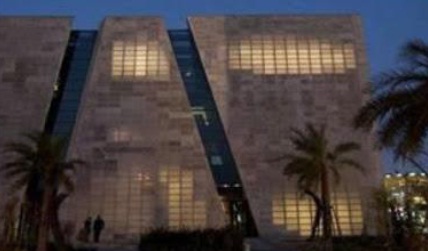
Due to globalization and construction of high-rise building, the space between buildings is reduced; this causes to increasing the use of non- renewable energy sources, so therefore there is a need of smart construction technique like green building and indoor thermal system. Translucent concrete (Transparent concrete) is new technique different from normal concrete. Translucent concrete allow more light and less weight compared to normal concrete. The use of sunlight source of light instead of using electrical energy is main purpose of translucent concrete, so as to reduce the load on non- renewable sources and result it into the energy saving. Optical fibers is a sensing or transmission element, so decrease the use of artificial light, the normal concrete is replaced by translucent concrete, which has natural lighting and art design.
Cement is a binder, a substance that sets and hardens as the cement dries and also reacts with carbon dioxide in the air dependently, and can bind other materials together. Portland cement is the most common type of cement in general use around the world, used as a basic ingredient of concrete, mortar, stucco, and most nonspecialty grout. The OPC was classified into three grades namely, 33 grade, 43 grade and 53 grade depending upon the strength of the cement at 28 days when tested as per IS 4031-1988. The cement used in this experimental works is “Koromandal King 53 Grade Ordinary Portland Cement”. The specific gravity of cement was 3.14. The initial and final setting times were found as 51 minutes and 546 minutes respectively. Standard consistency of cement was 40%.
Fine aggregate is the inert or chemically inactive material, most of which passes through a 4.75 mm IS sieve and contains not more than 5 per cent coarser material. The specific gravity 2.75 and fineness modulus of 2.80 were used as fine aggregate. The loose and compacted bulk Density values of sand are1600 and 1688 kg/m3 respectively, the water absorption of 1.1%.
The fine aggregates serve the purpose of filling all the open spaces in between the coarse particles. Thus, it reduces the porosity of the final mass and considerably increases its strength. Usually, natural river sand is used as a fine aggregate. However, at places, where natural sand is not available economically, finely crushed stone may be used as a fine aggregate.
Crush granite aggregate available from local sources has been used. The coarse aggregate with maximum size of 10mm having the specific gravity value of 2.6 and fineness modulus of 5.60 were used as a coarse aggregate. The loose and compacted bulk density values of coarse aggregate are 1437 and 1556 kg/m3 respectively, the water absorption of 0.4%.
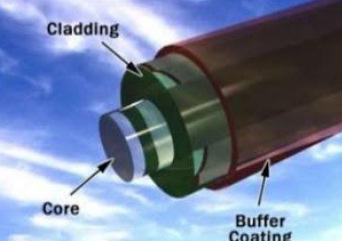
Core -
The thin glass center of the fiber where the light travels is called core.
Cladding -
The outer optical material surrounding the core that reflects the light back into the core. To confine the reflection in the core, the refractive index of the core must be greater than that of the cladding.
Buffer Coating –
This is the Plastic coating that protects the fiber from damage and moisture.
Water should be free from acids, oils, alkalies vegetables or other organic impurities. Soft waters also produce weaker concrete. Water has two functions in a concrete mix. Firstly, it reacts chemically with the cement to form the cement paste in which the inert aggregates are held in suspension until the cement paste has hardened. Secondly, it serves as a lubricant in the mixture of fine aggregates and cement
In the process of making light transmitting concrete, the first step involved is preparation of mould. The mould required for the prototype can be made with different materials which can be of either tin or wood. In the mould preparation, it is important to fix the basic dimensions of mould. The standard minimum size of the cube according to IS 456-2000 is 15cmx15cmx15cm for concrete. In the mould, markings are made exactly according to the size of the cube so that the perforated plates can be used. Plates made of sheets which are used in electrical switch boards is used which will be helpful in making perforations and give a smooth texture to the mould, holes are drilled in to the plates as shown in Fig. 4.1 The diameter of the holes and number of holes mainly depends on percentage of fiber used.
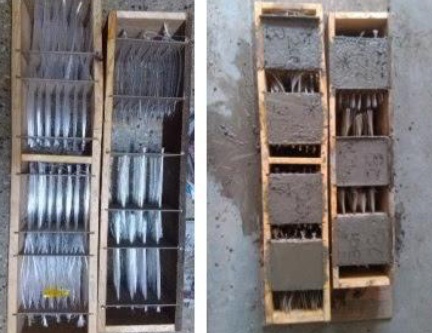
A mould of rectangular cross section of size 150mm*150mm*150mm is made with wood or steel. Make the required size of rectangular mould from wood or tin. Place the clay or mud in the sides where the optical fibers are exposed to the mould for the easy demoulding after the concreting.
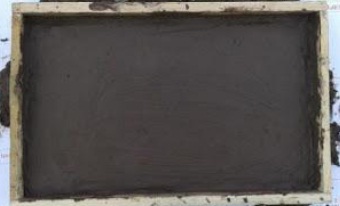
Fig. 4.2 Preparation of panel.
The optical fibers are cut carefully to the required size of mould. The commonly available diameters of optical fibers are .25 mm, .5 mm, .75 mm, 1 mm, and 2 mm.
Fibers are placed either in organic distribution or in layered distribution. Holes are driven on the wooden or steel plates through which optical fibers are allowed to pass through.
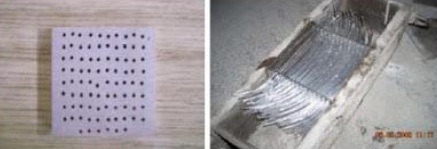
Fig. 4.4 Fixing of fibers.
The thoroughly mixed concrete is poured carefully and slowly without causing much disturbances to the previously laid optical fibers. The concrete is filled in smaller or thinner layers and is agitated with the help of vibrating tables to avoid the void formation.
After 24 hrs, remove the mould and pull off the mud. The casted mould was kept undisturbed on the leveled platform. Then it was de-moulded carefully after 24 hours from casting. Immediately after de-moulding, the cube specimens were marked by their respective identification mark/numbers (ID).
Cut the extra-long fibers same as thickness of panel. Polish the panel surface by using polishing paper or using sand paper
In order to study the light guiding property of translucent concrete, six units of translucent concrete is fabricated with different POF volume ratios of 1%, 2%, 3%, 4%, 5% and 6%, and the diameters of POF is 1mm. The transmittance is measured by the Optical Power Meter and its wavelength range is 400-1100nm. The incandescent lamp with 200W and halogen lamp with 500W are chosen to provide light. To eliminate the measuring dispersion of transmittance caused by the discrepancy of POFs’ position and the material, three areas (denoted as 1, 2 and 3) in the middle part of translucent concrete are chosen to test shown as figure below, and the number of POFs in each chosen area shall be equal. The number of the POFs is covered by transmission probe or integral sphere are 2 for 1% POF volume ratio, 4 for 2% POF volume ratio, 5 for 3% POF volume ratio, 7 for 4% POF volume ratio, 3 for 5% POF volume ratio and 9 for 6% POF volume ratio respectively. The incident light energy and transmission light energy are read simultaneously at each step.
By definition, the compressive strength of a material is that value of uniaxial compressive stress reached when the material fails completely. The compressive strength is usually obtained experimentally by means of a compressive test. The compressive strength of the concrete is determined by cast the cubes of size 150mm x150mm x 150mm.
Transparent Concrete can be used as building material for interior and exterior walls. If sunshine illuminates the wall structure, then eastern or western placement is recommended; the rays of the rising or setting sun will hit the optical glass fibers in a lower angle and the intensity of the light will be bigger. Besides the traditional applications of a wall, the light transmitting concrete can also be used as wall covering illuminated from the back.
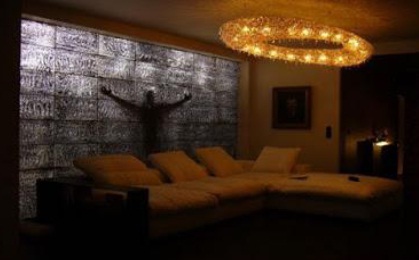
This concrete can be used as flooring a passable surface illuminated from below. During the day it looks like typical concrete pavement but at sunset the paving blocks begin to shine and in different colors.
The building units are versatile and can be used in many areas of design. Two successful designs using the light transmitting concrete were a jewel and a concrete bench. You can also create a logo with colorful figures, inscriptions, and pictures and can used for beautification purpose.
If you really want to create a look that stands out, you should opt for this artsy and vogue reception desk where light up in the front and the sides.
The transparent concrete cube is, without a doubt, a great conversation piece. The new cube line consists of four identical pieces of concrete and, due to its special geometry; the pieces form a stable structure without fixing them together.
It can be also applicable at:
Transparent concrete blocks suitable for floors, pavements and load-bearing walls.
Facades, interior wall cladding and dividing walls based on thin panels.
Partitions wall and it can be used where the sunlight does not reach properly.
In furniture for the decorative and aesthetic purpose.
Light fixtures.
Light sidewalks at night.
Increasing visibility in dark subway stations
Lighting indoor fire escapes in the event of a power failure.
Illuminating speed bumps on roadways at night.
The main advantage of these products is that on large scale objects the texture is still visible - while the texture of finer translucent concrete becomes indistinct at distance.
When a solid wall is imbued with the ability to transmit light, it means that a home can use fewer lights in their house during daylight hours.
It has very good architectural properties for giving good aesthetical view to the building.
Where light is not able to come properly at that place transparent concrete can be used.
Energy saving can be done by utilization of transparent concrete in building.
Totally environment friendly because of its light transmitting characteristics, so energy consumption can be reduced.
The main disadvantage is these concrete is very costly because of the optical fibers.
Casting of transparent concrete block is difficult for the labour so special skilled person is required.
A novel architectural material called transparent concrete can be developed by adding optical fiber or large diameter glass fiber in the concrete mixture. The transparent concrete has good light guiding property and the ratio of optical fiber volume to concrete is proportional to transmission. The transparent concrete does not loose the strength parameter when compared to regular concrete and also it has very vital property for the aesthetical point of view. It can be used for the best architectural appearance of the building. It can also be used in areas, where the natural light cannot reach with appropriate intensity. This new kind of building material can integrate the concept of green energy saving with the usage selfsensing properties of functional materials.
[I] Tina Lai "Structural behavior of Transparent Concrete and their applications to lightweight bridge decks" ,M.Tech thesis, MIT, 2009.
[2] Sergiu Cal in, Ciprian Asavoaie and N. Florea, "Issues for achieving an experimental model" Bul. Inst. Polit. la��i, t. LV (LIX), f. 3, 2009.
[3] Martina Schnellenbach-Held and Karsten Pfeffer,"Punching behavior of biaxial hollow slabs" Cement and Concrete Composites, Volume 24, Issue 6, Pages 551-556, December 2002.
| Are you interested in this topic.Then mail to us immediately to get the full report.
email :- contactv2@gmail.com |